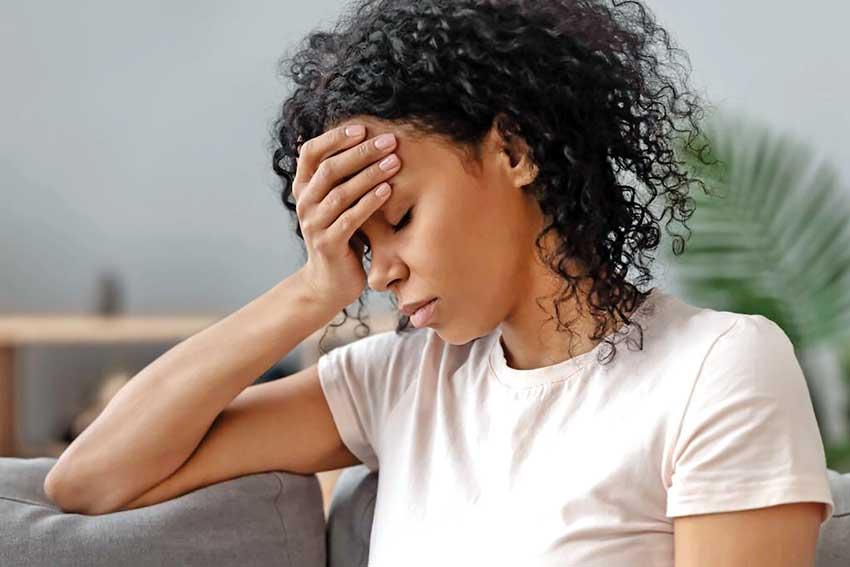Reply To:
Name - Reply Comment

The more you don’t treat it, the migraine becomes more severe where the patient has to lay in a quiet dark room for days
Migraine affects more women than men (2/3rd women and 1/3rd men) and women are usually affected during the prime time of productivity
However, the field of neurology has evolved with a breakthrough medicine to abort migraine headaches with less side effects
 The migraine headache is known to be the second most disabling medical condition after lower back pain. This disabling headache that keeps you from doing your day-to-day activities, confining you to a bed in a dark room is said to be common among most females than males. But as of late, new research has introduced medication that could abort this headache and help patients return to normal function.
The migraine headache is known to be the second most disabling medical condition after lower back pain. This disabling headache that keeps you from doing your day-to-day activities, confining you to a bed in a dark room is said to be common among most females than males. But as of late, new research has introduced medication that could abort this headache and help patients return to normal function.
In a candid interview with the Daily Mirror, Dr. Ruwani Gunawardane, a neurologist practicing in the United States, specializing in migraines, multiple sclerosis, stroke and other neurological disorders spoke extensively about Gepants – the new breakthrough medicine that can be used on migraine patients, irrespective of age or underlying cormobid conditions.
Nature of migraine
|
Dr. Ruwani Gunawardane - Neurologist |
“A migraine has four phases,” explained Dr. Gunawardane in an interview with the Daily Mirror. “The first phase is the prodrome phase where the patient knows that the migraine is coming. Symptoms include irritability, craving for certain foods such as chocolates and carbohydrates, yawning. Then they go into an aura and around 30% of patients can experience visual and speech disturbances. They can see the periphery, zigzag lines in their visual field and they even have weakness on one side which is like a stroke. That’s called an aura which is usually reversible. Then they go to the headache phase which could be moderate to severe. Migraine also has light and sound sensitivity, nausea and vomiting and that’s why migraine headache is now termed the second most disabling medical condition after lower back pain. The fourth phase is where the patient has a brain fog, they have a hangover, they feel dizzy and wobbly and it can go on for days.
“A migraine headache is not just about headache symptoms, but there are associated symptoms. It has a prodrome and postdrome phase and it’s a progressive disorder. The more you don’t treat it, the migraine becomes more severe where the patient has to lay in a quiet dark room for days. The migraine headaches get worse if there is even a slightest exertion. 90% of the time we find patients with a family history of migraine. As such there’s a genetic predisposition for migraine. Patients have to lay still in bed with curtains closed. It affects more women than men (2/3rd women and 1/3rd men) and women are usually affected during the prime time of productivity. Migraine hits you at the busiest time of your life when you have to raise children, go to work etc. After menopause migraine becomes less severe. Most patients do not have migraines by then, but 5-10% of patients will continue to have migraine headaches. But in the case of men, they do not have menstrual cycles and therefore they could get a migraine at any point of their life,” she added.
Previous medication and treatments
Speaking about medication and treatments, Dr. Gunawardane said that there’s no cure for migraine as it is a progressive brain disorder, but that migraine can be controlled with prevention medications. “Therefore some patients hardly have a headache as it is manageable and therefore they are not missing out on work. There were always treatments to rescue the headache and it was gratifying when patients who came with severe disabling headaches during their first visit would say that the medication worked during their second visit. They didn’t suffer for too many hours and were able to bounce back to their daily functions.
“The key thing is that migraine is now considered a neurobiological disorder. It’s a progressive brain disorder which becomes chronic. If you don’t treat it adequately, the next headache becomes more severe and disabling. There has been a lot of research to get the best treatment and people have been keen on new findings and cutting edge therapies. During 1990s there were medications called Triptans which are now available in Sri Lanka. Even though it was an effective treatment to abort headaches, there were certain drawbacks. When patients took it during work they experienced chest tightness, they felt foggy, dizzy and preferred to take medication when they went home. Therefore there was a delay in starting treatments,” said Dr. Gunawardane.
Breakthrough discovery
However, the field of neurology has evolved with a breakthrough medicine to abort migraine headaches with less side effects. “Recently there was a breakthrough news in medicine, the discovery of one of the most important neuropeptides that are released with migraine. This is called Calcitonine Gene-Related Peptide (CGRP). Researchers have thought that if they blocked CGRP they could quickly and efficiently abort the headache. CGRP antagonists are available for acute and rescue treatment but also for prevention as well. I haven’t been doing research on this particular molecule but have been fortunate to use medication and see patients bounce back quickly to normal function.
“Usually migraine headaches can last several hours to days,” she continued. “The new treatments that have evolved have made practice much rewarding for patients. In the past we had prevention medication which were non-targeted medication. So they were either anti-epileptic medication such as Topamax, blood pressure medication or tricyclic antidepressants. Prevention is the most important treatment for migraine patients. But patients who had the anti-epileptic Topamax had a lot of brain fog and there was numbness and tingling of hands and feet and patients were never complying and there was poor adherence to medication. It took several weeks to months for medication to take effect. The blood pressure family medication had to be of limited use because in young patients their blood pressure was low and when this medication was used they commonly got dizziness. In the case of antidepressants patients were not excited getting anti-depression medication for their migraine treatment. So we did have treatments but they were non-focused treatments. The efficacy was not too bad but there were side effects and patients were never complying.
“But the new treatment medication called Gepants antagonise the CGRP. It not only gets rid of migraine but there are prevention treatment made throughout the world. The Gepants are small protein molecules that block the CGRP and patients can even take this medicine at work. The problem with migraine is restoring to normal function as it may take several hours to get back to normal but the newer generation medication are focused and therefor there are less side effects. There are no side effects such as chest tightness or central nervous system drowsiness. Around 4% of patients can have nausea and another 3-4% of patients can have constipation.
Therefore this medication has a low side effect profile and they are quick to act. Patients do not have migraines that would last 2-3 days. A lot of patients such as women with menstrual migraines can have migraines that can last for around 3-4 days. Therefore with novel therapies it is an exciting time for us to practice migraine treatments,” she added.
A drug recommended for any and all patients
Sri Lanka has an ageing population and already, many among the elderly are diagnosed with neurodegenerative disorders such as Alzheimer’s and dementia. But in the case of migraines it is not so. “After menopause migraines subside significantly except for a minority of patients. It’s not seen much in the elderly but it could continue. The migraine headache isn’t a big neurological disorder we see in the elderly. However, Gepants don’t cause vasoconstriction. We couldn’t use Triptans on older patients because during a headache the blood vessels stretch and the Triptans would bring blood vessels together. Thereafter, the headache goes away. But older patients were worried that this medicine would precipitate a heart attack and stroke. Therefore there was limited medication for older patients when they had migraines. But the Gepants don’t cause vasoconstriction, they block the CGRP and prevent vasodilation. Therefore it could be used on older patients, patients with severe high blood pressure, high cholesterol and other cormobid conditions. But if they had a heart attack immediately we wouldn’t use Gepants because during a heart attack we want blood vessels to dilate. Patients with chronic heart disease or diabetes or increased cardiovascular risk factors could use Gepants to get rid of headaches.” the doctor explained.
She further said that Gepants do not cause rebound headaches. “The Triptans do cause rebound headaches. Another good feature about Gepants is that they don’t cause drug addiction. Some patients with chronic migraines opt for narcotics when they feel that none of the medication works. Narcotics is definitely not the right treatment as it causes addiction and rebound headaches. Gepants don’t cause weight gain, drowsiness and they return you back to normal function quickly. As such, this medication has revolutionized migraine treatments,” said Dr.
Gunawardane
Post-COVID scenario
From a neurological perspective, COVID is referred to as a neurotrophic virus. “It loves the brain. That’s why you lose smell. It goes through the nose and affects cranial nerve I as its in the passage, then the olfactory nerve gets affected. That’s why you lose smell. Then it travels further to the brain and causes memory problems, neuralgia and tremors. A lot of COVID patients end up with tremors. Some patients end up with progressive disorders and are at risk of getting Alzheimer’s or dementia. The virus also loves the hematopoietic system and that’s why patients get blood clots and die the next day. It may also lead to the amputation of their limbs or fingers or cause blood clots in the lungs. It’s an unbelievable virus that release cytokines and inflammatory peptides and cause fatal outcomes.” the doctor added.
She further observes an increase in the number of patients complaining of migraines post-COVID. “This is mostly because patients were sedentary and they worked from home. So the pattern changed. Going to work was good for patients because they spoke to people, socialized and they had less stress. But at home they would sleep more. I’ve noticed that some patients would have migraines only on a Saturday because of the ‘Let-down’ phase.
Migraine patients need to have a regular sleep pattern. They cannot wake up at 6am to go to work on weekdays and sleep on Saturday and Sunday till 10am. When they sleep late, their breakfast is missed on Saturdays and missing meals triggers migraines. The other trigger is disrupted sleep patterns. During the pandemic there was a lot of weight gain due to sedentary lifestyles and stress eating. But we were able to manage those patients on telemedicine. There was nothing much to examine and especially established patients who had high frequency headaches didn’t have to end up in the emergency room. I always encourage my patients to get the vaccine and I managed to convince patients by educating them on benefits of the vaccine.” said Dr. Gunawardane.
In her concluding remarks, Dr. Gunawardane said that it’s an exciting time for neurology practice with newer treatments and medications introduced to prevent migraines.